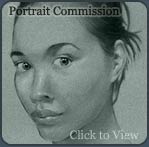Patterns, Rhythm, Movement |
|||||||||||||||||||||
|
Page 05 / 07
HORSES AND MOVEMENT from PAINTINGS and DRAWINGSWhistler on a certain occasion, after studying deeply the border of a Japanese mat, exclaimed that its design had revealed to him how to express motion by pattern. Although, when a movement is so regular as to be expressed diagrammatically as a straight line or a circle, there is nothing in such lines to suggest that there is flow in either direction, yet patterns can be so designed that the spectator's eye is irresistibly led across them in the intended direction and at the intended speed. When inventing such patterns the artist resembles the author, who so constructs his passages that he compels the reader to read them fast or slowly, smoothly or abruptly, according to the particular feeling he wishes to arouse. Good illustrations of this principle are to be met with everywhere, for instance in the ornamental borders of books, or ancient Chinese bas-reliefs, where figures, plants and patterns flow into each other, leading the eye along the mere patterns with the same sense of motion that it feels in looking at the running figures. Or test the effect of pattern by taking some turbulent picture by Rubens or Goya, or a quieter subject by Botticelli or Watteau, and looking at them upside down. You will soon see if the rhythms are expressive. For by so doing you will be less able to see what the figures are about, or to reason out the action of the picture, and you will be more directly affected by the design, so as readily to detect the shortcomings of the group of pulling figures in the picture first instanced, and to enjoy more consciously and fully the effect of great work. To take two pictures by Rubens, you will notice how in the " Country Dance " in the Prado Gallery the background contributes to the action of the figures, how the trees and landscape forms dance and turn in sympathy with the group of dancers, and how in his " Lion Hunt " at Munich the shapes made by the shields, plumes, horses' tails and all add to the savageness of the struggle. 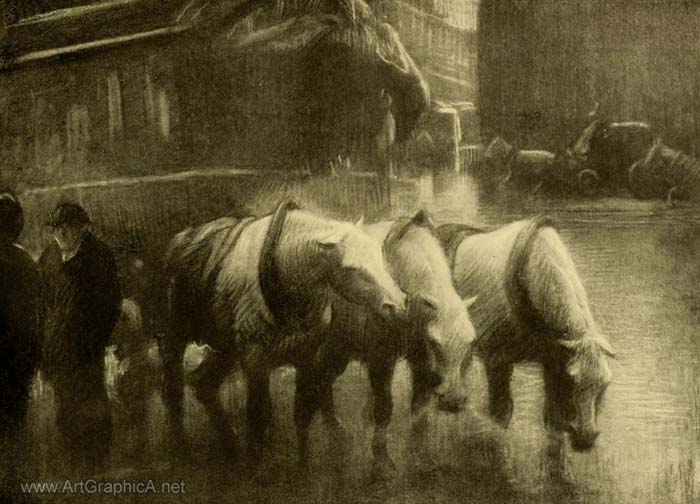 BETWEEN THE STAGES : PARIS. Horse art, drawing. You may also notice in his more violent pictures how little the parts are allowed to hold your attention : that though the details of the heads and other parts are to be found, if you look for them, they are skilfully subordinated so as not to arrest your eye for long from following the swirling pattern. Is not this again a truth to nature ? For when looking on at such a scene we should be watching the action, not noticing details of the actors. How far the underlying_ basic rhythms of such pictures resemble nature's rhythms it would be difficult to determine. Yet we are often struck by the vividness and exactness with which some lively sketch recalls a natural movement.  ON THE TOP OF THE BANK. Horse art, drawing. Artists must vary as much in their perception of movement as they do in that of colour, tone or form. Some must have quicker eyes than others. The normal eye requires, I think, fourteen films to the second in the cinematograph if it is not to notice any interruption in the continuity of the picture on the screen, though the required number varies with the intensity of the light. Both quick and slow eyes see no doubt beauty and interest invisible to each other. Every artist, then, has a different problem, and must discover for himself how to convey his impression. He must rely upon his own firsthand observation interfered with as little as possible by the vision of others, or the vision of the camera. 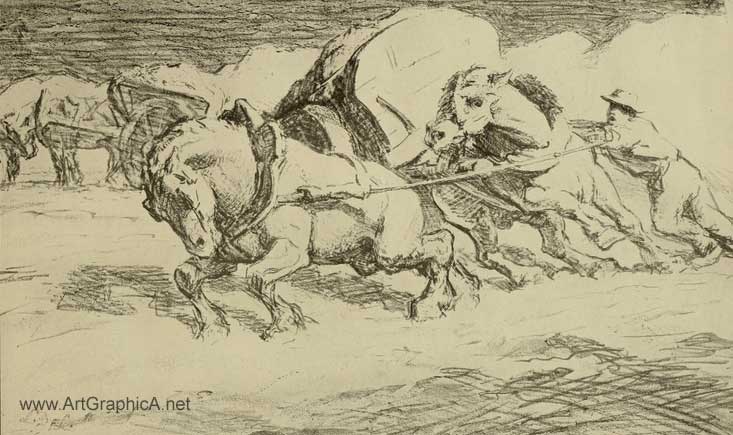 SAND-CARTS. Horse art, drawing. The following quotation from a conversation with Rodin, given in " L'Art " by Gsell, bears directly upon this question of how the observer's eye is led about a work of art, and shows how admittedly conscious an artist can be of the influence of such principles in his own work. " It is possible," said Rodin, " for a sculptor to create the illusion that the muscles of his statues really move by not representing every part of the figure at the same instant of time. . . . In the statue before you, for instance, the legs, the hips, the body, the head, the arms are given, not at the same moment, but at intervals of moments. I am applying no theory here, I am following an instinct which leads me to express movement in this way. As a result, when the spectator sweeps his eyes from one end of my statues to the other, he sees their gestures grow. He follows the muscular effort across the different sections of the figure from its slow inception to where it culminates." 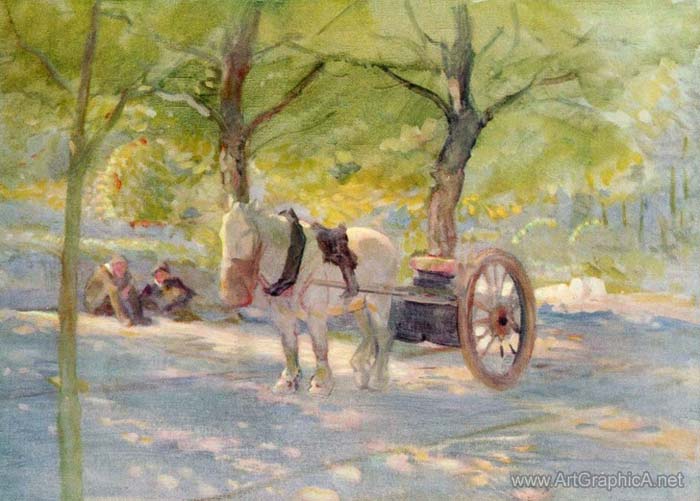 UNDER THE TREES. Horse art, painting. We may notice particularly that Rodin declares that such a method is instinctive, although he is able to analyse the cause of his success in rendering the movement. Rodin insisted very strongly upon the necessity of studying the model in motion. For whatever study is made of the posed model, it must never be allowed to supplant or to obscure the impression derived from the moving figure. He used to point out that the swing of one side of the body is only possible because of the movement of the other side. It is the observation of this principle, he declared, which makes his St. John walking and not posing. It is impossible for a model to " take the pose " of a man walking, quiet as the movement is. 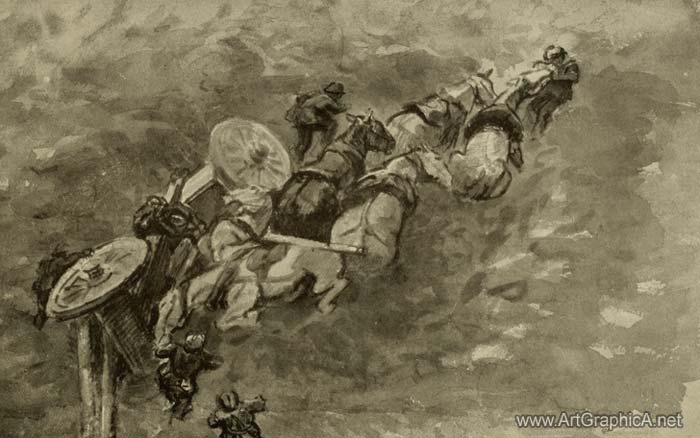 GUN-TEAM IN A CRATER. Horse art, drawing. The forward inclination of the body of a man running cannot be imitated by a posed model. For in running the impetus is in itself a support to the body. He used as an obvious illustration of the falseness of the " posing of a movement " the case of a man hammering. So long as he holds the hammer in " the pose " he is contradicting the sense of it all. He is contracting the muscles which prevent the arm and hammer falling, and relaxing those which should be pulling it down. 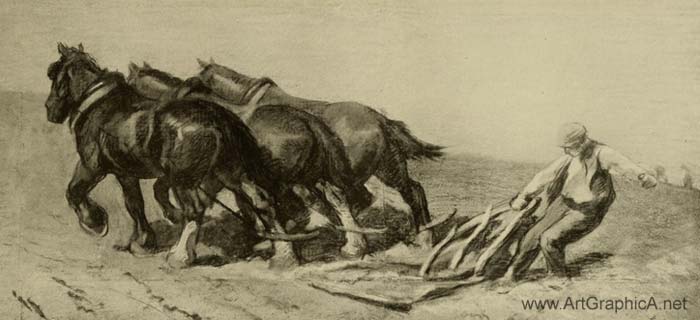 HARROWING. Horse art, drawing. Truisms ? Yes, but truisms too often neglected in art because obscured or lost in the exclusive, or almost exclusive, study of the posing model. Yet we all know that if we receive a violent push on the shoulder we inevitably slew round, because one side of us is, so to speak, walking forward more rapidly than the other. The model posing is as true an example of this law of the interdependence of parts as a man in action. For it is only by keeping the right side of his body still that he can keep his left side unmoved also. If an artist is content to accept the pose of the model as a substitute for the observation of natural movement, the better he draws the more completely will he defeat himself -- for the better he draws the more perfectly does he express the model's immobility. 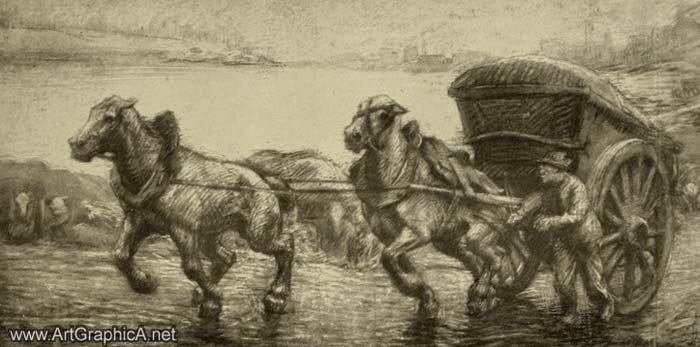 UP THE RAMPE. Horse art, drawing. Rodin's analysis of how the impression of movement in his statues is created is, I am afraid, not much of a working rule, applied as such. Is it not rather one of the rules to which Sir Joshua Reynolds refers in his Sixth Discourse ? " The rules by which men of extraordinary parts, and such as are called men of Genius, work, are either such as they discover by their own peculiar observations, or are of such a nice texture as not easily to admit being expressed in words . . . Unsubstantial, however, as these rules may seem, and difficult as it may be to convey them in writing, they are still seen and felt in the mind of the artist ; and he works from them with as much certainty as if they were embodied, as I may say, upon paper. It is true, these refined principles cannot be always made palpable, like the more gross rules of art ; yet it does not follow, but that the mind may be put in such a train that it shall perceive, by a kind of scientific sense, that propriety which words, particularly words of unpractised writers, such as we are, can but very feebly suggest."
Next Page
Prev PageAnimals in Motion Movement and Direction
|
|||||||||||||||||||||








